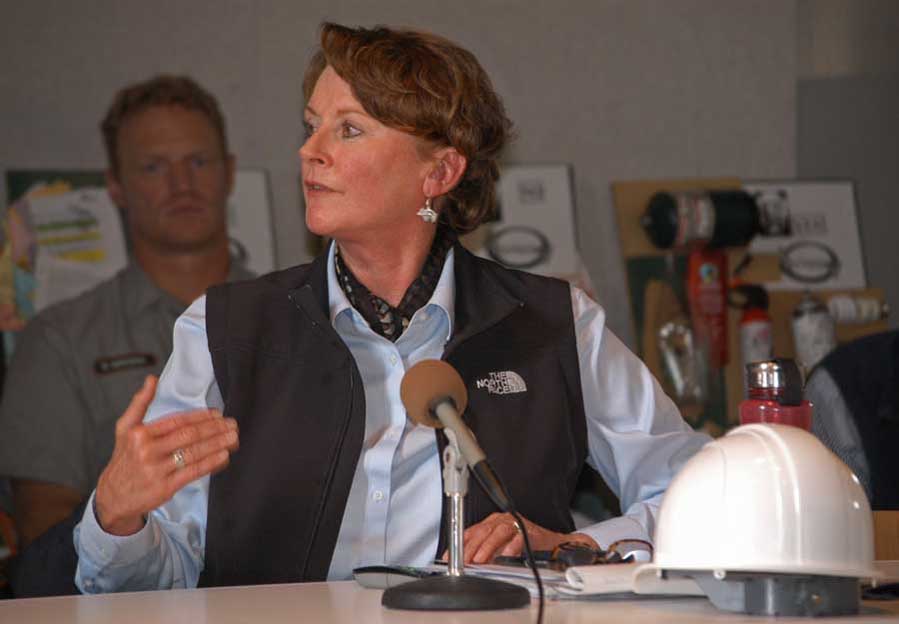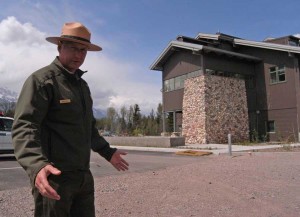
Grand Teton National Park Superintendent Mary Gibson Scott speaks last month during an annual briefing for local elected officials. (Ruffin Prevost/Yellowstone Gate - click to enlarge)
By Ruffin Prevost
MOOSE, WYO. — Grand Teton National Park Superintendent Mary Gibson Scott had a construction hard hat sitting on the table next to her during a presentation last month for local elected officials. It wasn’t just a prop, as Scott and other National Park Service employees had just moved into their recently completed new office space in Moose, and a range of construction and improvement projects are in the works for this summer and beyond.
Grand Teton has a $193 million deferred maintenance backlog, Scott told Jackson Hole area elected officials in her annual briefing of the park’s upcoming summer season.
“We’re gradually correcting it over time,” she said. “But it’s a continuing effort.”
Grand Teton has built or had a hand in $80 million worth of improvements over the last few years, Scott said, and more projects are in the works, including road resurfacing throughout the park.
Visitors can expect delays of 15-30 minutes at various spots throughout the park this summer as road crews work primarily to lay down new asphalt, Scott said.
New traffic counters installed throughout the park may yield slightly different visitation numbers for the 2012 season, she said, but overall, park visitation has remained steady over the last several years, and early reservations indicate this year “looks like a fairly strong summer.”
Grand Teton has seen an average of close to 3.9 annual total visitors in recent years, with about 2.7 million annual recreational visitors in 2010 spending more than $424 million in the park and nearby communities, according to a recent National Park Service study.

Chris Finlay, Grand Teton National ParkÕs chief of facility management, leads a tour of the National Park Service headquarters for the park in Moose. (Ruffin Prevost/Yellowstone Gate - click to enlarge)
Some park administrative staff recently moved into newly renovated offices in a former maintenance building that now sports a silver certification from the Leadership in Energy and Environmental Design program, along with sweeping mountain views. Additional work on the project will wrap up later this year.
The upgrade is a welcome change from a hodgepodge of temporary trailers and prefabricated buildings that staffers had been using for office space. Scott said one employee joked that he was “not used to being in an office that doesn’t have a trailer hitch.” The project will consolidate buildings along the Snake River and shrink the developed and paved footprint at the Moose headquarters area, resulting in a net reduction of 8,000 square feet of office space, Scott said.
Moose employee housing project
Completion is expected by late August on a $13.2 million employee housing project in Moose that will create seven four-plex units with gold LEED certification.
Employees pay rent at government housing units in Grand Teton and other parks, but the rent of Grand Teton workers living outside the park has been subsidized by the Park Service. Completion of the housing project in Moose would allow those employees receiving government rent subsidies to move out of those privately owned rental units where they are competing for scant housing in the local community, she said.
The park is currently reviewing public comments on its environmental assessment of a plan to replace the 50-year-old wastewater system at Moose and to upgrade other deficiencies in the community’s water systems.
Planners say the project would ensure efficient wastewater and water services, improve public health and safety, and meet requirements for fighting structural fires at the Moose and Beaver Creek developed areas. The preferred alternative proposed by the Park Service would replace most water system pumping, storage and transmission components. It would provide gravity flow of water for firefighting and potable use from a new 300,000-gallon tank located near Taggart Creek. A new wastewater treatment plant would be constructed near the Moose Post Office.
Planners expect to release by fall a draft comprehensive resource management plan for the Snake River which would implement the requirements outlined in the 2009 Craig Thomas Snake Headwaters Legacy Act.
The plan will classify segments of the river and nearby waters and provide a clear process for protecting the river’s free flowing conditions. It will also address user capacity and specific visitor facilities within each river. Park managers said that while river use dipped in 2009 following the economic crash, it has since mostly rebounded and remained steady.
Park planners will also work with concessioners to study how they might consolidate a series of parallel and duplicative trails within the park that unnecessarily fragment wildlife habitat, Scott said. Many of the trails under consideration for elimination are created by users, and are not officially designated and maintained by the Park Service.
Contact Ruffin Prevost at 307-213-9818 or ruffin@yellowstonegate.com.
